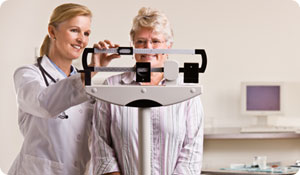
What's your pefect body weight? 125 pounds? 150 pounds? Anything under 200? The truth is, a healthy body is defined by much more than what size jeans you wear, how you look in a bathing suit, or even what the scale says. For example, did you know that the distance around your waist, regardless of your weight, can determine your risk for serious health conditions such as heart disease? So, before you hop on the scale for the umpteenth time this week, consider these two effective ways to assess your body composition, as recommended by the American Heart Association.
Body Mass Index (BMI)
This measurement assesses your body weight relative to your height. It's a useful way of measuring body composition because it correlates highly with body fat in most people. To calculate your exact BMI value, multiply your weight in pounds by 703, divide by your height in inches, then divide again by your height in inches. For adults, a body mass index:
- Over 40 is defined as extremely obese.
- Over 30 is considered obese. People with BMIs of 30 or more are at higher risk of cardiovascular disease.
- Between 25 and 29.9 is considered overweight. People with BMIs in this range have an increased risk of heart and blood vessel disease.
- Between 18.5 and 24.9 is considered healthy.
- Under 18.5 is consider underweight.
Some people with dense muscle mass may have a high BMI score but very little body fat. For them, it may be more accurate to choose waist circumference or another direct method to measure body fat.
Waist Circumference
To measure your waist circumference, place a tape measurer around your waist, at the level of your navel. Your waist circumference is an indirect indicator of intraabdominal fat tissue, often called visceral fat. If your BMI is greater than or equal to 25 kg/m2, your goal for waist circumference is less than 40 inches if you're a man and less than 35 inches if you're a woman. A large waist circumference is associated with an increased risk of type 2 diabetes, high cholesterol, high blood pressure, and cardiovascular disease, due to excess abdominal fat.
Dangerous Implications
Being overweight or obese also increases your risk of dying from cancer, according to the American Cancer Society. In a study published in the New England Journal of Medicine, researchers determined that obesity may account for 20 percent of all cancer deaths in U.S. women and 14 percent in U.S. men. Their work also supports previous studies linking obesity to cancers of the uterus, kidney, esophagus, gallbladder, colon and rectum, and breast (in postmenopausal women). The researchers also found that many types of cancer not previously linked to obesity were, in fact, affected by excess body weight. These include cancers of the liver, pancreas, prostate, cervix, ovary, and stomach (in men), as well as non-Hodgkin lymphoma and multiple myeloma.
To maintain a healthy body composition, the American Cancer Society recommends balancing calorie intake with physical activity by eating at least five servings of fruit and vegetables every day, choosing whole grains over processed grains, and limiting red meat consumption. Individuals should engage in at least 30 minutes of moderate physical activity five days a week.





